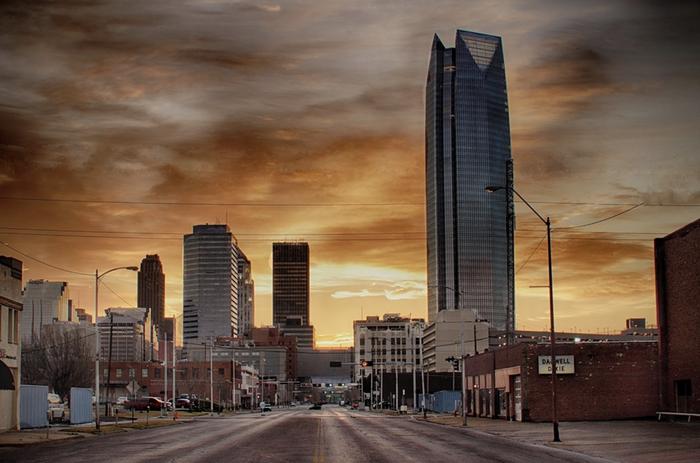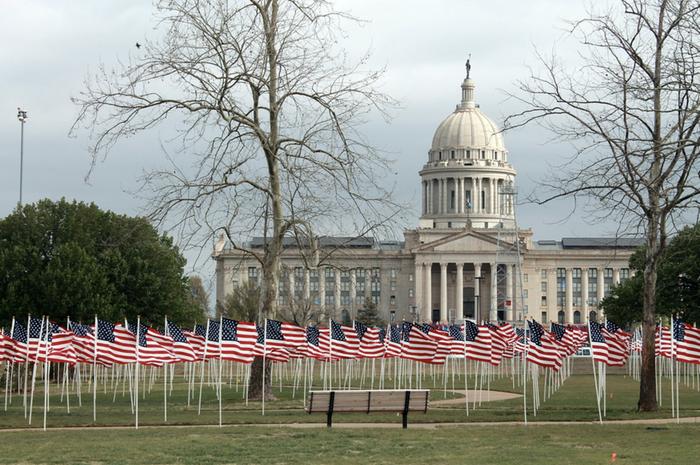What is the weather like in Oklahoma City?
Oklahoma may be the tornado capital of the United States. The region has a very high thunderstorm activity.

The climate of Oklahoma City is classified as humid subtropical with very hot and humid summers and cool winters with occasional snow. The rainfall peak is in late spring and early summer due to thunderstorm events. Winters are drier.
The temperature range between different months and seasons can get huge in Oklahoma City. The official heat record is 113 °F (45 °C) and the cold record −17 °F (−27 °C). Typically the hottest months are July and August and the coldest month is January.
Oklahoma City weather in summer: Watch out for thunderstorms and extreme heat
Summers usually begin with frequent thunderstorms and very humid weather. The conditions for heavy rainfall accompanied with intense lightning are favourable from April to late June. This is the wettest period of the year.
As summer continues, drier weather usually takes over and rainfall amounts start to decrease during July and August. This is when the city may get extremely hot. On average, Oklahoma City sees temperatures surpassing 100 °F (38 °C) on 12 days of the year and temperatures reaching 90 °F (32 °C) on nearly 70 days.
Usually the extreme heat waves are caused by stable and long lasting high pressure systems. Unfortunately, this weather pattern may bring prolonged drought and trigger severe wildfires especially towards the end of the summer.
On the other hand, Oklahoma City and its vicinity are prone to flash flooding due to high amounts of humidity in the atmosphere.

Oklahoma City weather in winter: Drier and cooler
Winters of Oklahoma City are cooler and drier. Precipitation amounts reach annual lows during the winter months, January being the driest month of the entire year. Winters are drier because thunderstorms and cyclone activity become less frequent in in the continental parts of the United States in the winter months.
Despite the fact that Oklahoma City is located in the subtropical latitudes, the weather can occasionally get quite frigid. Cold, arctic air masses from Canada may cause temperatures to drop to as low as –10 °F (–23 °C). Occasional blizzards can also occur. On average, Oklahoma City has five snowy days per year. The snowiest day on record was Christmas Eve in 2009 when 13.5 inches (34 cm) of snow fell within 24 hours.
Usually winter days are mild and daily high temperatures settle to around 50 °F (10 °C). Occasional summer-like days can happen when warm air masses push their way from the Gulf of Mexico towards the North.
| Month | Daily mean °F (°C) | Avg daily max °F (°C) | Avg daily min °F (°C) | Avg precip inc (mm) |
|---|---|---|---|---|
| January | 39.2 (4.0) | 49.7 (9.8) | 28.8 (–1.8) | 1.39 (35) |
| February | 43.7 (6.5) | 54.6 (12.8) | 32.8 (0.4) | 1.58 (40) |
| March | 52.2 (11.2) | 63.4 (17.4) | 41 (5.0) | 3.06 (78) |
| April | 61 (16.1) | 72.3 (22.4) | 49.7 (9.8) | 3.07 (78) |
| May | 69.9 (21.1) | 80.2 (26.8) | 59.6 (15.3) | 4.65 (118) |
| June | 77.9 (25.5) | 88.1 (31.2) | 67.8 (19.9) | 4.93 (125) |
| July | 83.1 (28.4) | 93.9 (34.4) | 72.2 (22.3) | 2.93 (74) |
| August | 82.3 (27.9) | 93.4 (34.1) | 71.3 (21.8) | 3.28 (83) |
| September | 73.9 (23.3) | 84.7 (29.3) | 63.2 (17.3) | 4.06 (103) |
| October | 62.5 (16.9) | 73.4 (23.0) | 51.6 (10.9) | 3.71 (94) |
| November | 50.8 (10.4) | 61.5 (16.4) | 40 (4.4) | 1.98 (50) |
| December | 40.6 (4.8) | 50.6 (10.3) | 31.3 (–0.4) | 1.88 (48) |
In the middle of the "Tornado Alley"
When it comes to tornado activity and lightning density, Oklahoma is among the worst-affected states. The most active severe weather season kicks in already in March and lasts until July. Especially April and May bring along severe thunderstorms with hail and tornadoes.
Oklahoma City lies in the heart of the so-called Tornado Alley – the region with the most intense and frequent tornadoes on Earth. Tornadoes can occur in every month of the year and Oklahoma City is known to be one of the most tornado-prone cities in the world. Altogether more than 150 tornadoes have struck Oklahoma City since 1890.
One of the deadliest tornadoes on Earth struck southern parts of Oklahoma City on May 3, 1999. The tornado reached F5 on the Fujita scale and the highest wind speeds estimated by the radar were 318 mph (510 km/h). Another violent F5 category tornado hit parts of Oklahoma City on May 20, 2013. The tornado was up to 1.3 miles (2.1 km) wide.






